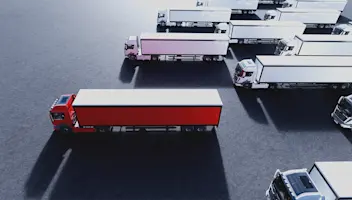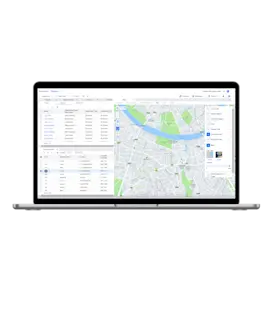Featured in this post
What Is Route Optimisation Software and How Does It Work?
What Is Route Optimisation Software and How Does It Work?
18 Feb 2025
Aptean Staff Writer
Ever wondered what sets logistics leaders apart? It’s not their fleet size or the resources at their disposal—it’s their ability to optimise those resources, doing more with less to maximise profitability. And their secret weapon? Technology.
Whether it’s harnessing artificial intelligence (AI) to boost productivity, leveraging predictive analytics to reduce operational risks or investing in advanced driver-assistance systems (ADAS) to improve safety, industry trailblazers know technology is the key to driving success.
While some of those may seem like distant investments for many companies, there’s a simple first step on the road to logistics digital transformation: deploying route optimisation software to power efficiency and elevate customer service—all at once.
With customer expectations at an all-time high, the old ways of manually planning routes or relying on guesswork simply don’t cut it anymore. Every delay, every unnecessary mile travelled and every missed delivery window chips away at your bottom line and customer satisfaction.
That’s why routing and scheduling software is key. It's more than simply finding the shortest path—it’s about balancing cost-efficiency, time savings and customer requirements to deliver exceptional results. This blog dives deep into what route optimisation software is, how it works and how it can help your business stand apart from other logistics companies.
What Is Route Optimisation?
Route optimisation is the process of planning and determining the most efficient path for vehicles to complete activities like deliveries, pickups, service calls or other logistical tasks.
Traditionally, commercial route planning—getting trucks from A to B—was handled manually by experienced planners. These individuals used maps, spreadsheets and their local knowledge to create routes. For small operations, route planning alone can create mostly effective and reliable routes, but route optimisation goes a step further. This process ensures the path taken minimises time, distance and costs while considering various constraints, such as delivery time windows, customer requirements, traffic conditions, driver availability and vehicle capacities.
As route optimisation helps you effectively manage your fleet, it brings many benefits—fewer miles travelled means reduced fuel consumption, lower carbon emissions and quicker delivery times. These advantages extend to cost savings, improved resource utilisation and enhanced customer satisfaction.
But achieving this level of efficiency manually is no small feat—especially when you’re juggling hundreds of variables. That’s where software steps in to streamline and transform the process.
What Is Route Optimisation Software?
Route optimisation software—also known as routing and scheduling software—is an advanced tool that automates and optimises route planning for an entire fleet, factoring in your business’s unique requirements and constraints. Not only does this save planners the headache of doing it all manually, but also improves the final output—boosting efficiency and reducing costs.
While the traditional hands-on approach gets the job done, it’s slow, complicated and far from efficient. Instead, with route optimisation software, you can remove the guesswork from your logistics planning and let the system handle the heavy lifting through smart algorithms and automated processes. The result? You get accurate routes in minutes, smoother daily operations and elevated customer service.
As well as improving batch and dynamic route planning, the best route optimisation software also offers live route execution tools to streamline on-the-day processes and provides strategic route planning capabilities to enable data-driven decision making.
Ultimately, route optimisation software helps you move beyond reactive problem-solving and toward proactive efficiency. It doesn’t just find routes from A to B—it optimises them, making life easier for dispatchers, drivers and customers alike.
How Does Route Optimisation Software Work?
Routing and scheduling software is a powerful logistics tool that combines your business-specific data, cutting-edge optimisation techniques and dynamic adjustments, to ensure you’re operating with precision and reliability—all while maximising productivity and reducing costs. But how exactly does it do that? Let’s break down its functionality into actionable steps and critical considerations:
Key Steps Covered by Route Optimisation Software
Data Input - In order to create feasible and accurate routes, the system must be furnished with your business-specific variables, including delivery locations, time windows, vehicle capacities, driver shifts and skills, and customer requirements. Good route optimisation software should integrate with your other systems, such as order management, enterprise resource planning and fleet management tools to create a comprehensive and accurate dataset.
Optimisation Algorithms - Algorithms are the backbone of route optimisation, transforming raw data into actionable plans. These algorithms—ranging from heuristic to metaheuristic methods—analyse constraints such as delivery deadlines, traffic patterns and road restrictions to evaluate millions of different possible route permutations, quicker and more accurately than any human brain or spreadsheet could ever achieve.
Route Planning - Once the algorithm identifies the optimal routes, the software sequences stops to ensure you’re achieving customer promises in the most cost-effective way. This includes considering special requirements such as ad-hoc pickups, multi-depot operations and backhauls, ensuring the plan is both feasible and efficient. All this means you can confidently provide regular shift patterns to your drivers and estimated time of arrival data to your customers.
Live Management - As conditions evolve, such as traffic congestion or weather changes, systems with route execution functionality keep you in the loop. This live management capability ensures you can proactively control daily progress, reducing delays and enhancing customer satisfaction by ensuring punctuality.
Reporting and Strategic Capabilities - The wealth of data recorded by the system is then collated into detailed reports, highlighting key performance metrics (KPIs) and offering actionable insights for continuous improvement. Plus, strategic modelling capabilities allow you to test the impact of different initiatives, such as new depot locations, additional customers or changing driver shift times, before implementation—helping reduce risk and prioritise profitability.
Key Variables Considered by Route Optimisation Software
As we mentioned, while planning efficient routes, your routing and scheduling software considers several variables. Let’s dive in for a closer look at a few of the most critical factors:
Delivery Time Windows – A route optimisation system ensures deliveries or service stops are scheduled within precise time frames, maintaining customer satisfaction and avoiding penalties.
Traffic Conditions and Road Restrictions - Leveraging historical traffic data and average road speeds, the software identifies the quickest paths while avoiding typically congested areas, low bridges, one-way streets and more.
Vehicle Capacity and Type – Advanced optimisation includes balancing vehicle load limits while maximising capacity utilisation and factoring in vehicle type considerations like electric vehicle charge length.
Multiple Depots and Collections - For fleets operating across various hubs or performing collections as well as deliveries, route optimisation software creates routes that seamlessly integrate multiple starting and ending points, enhancing resource utilisation and reducing empty mileage.
Driver Attributes and Preferences - Take into account driver availability, skills, certifications and shift preferences to improve accuracy, ensure driver hours compliance and boost job satisfaction, critical in this time of labour shortages and retention woes.
Routing and scheduling software accounts for these variables and many others straight out of the box. And the best systems also provide customisable routing rules allowing you to integrate local knowledge, niche customer requirements and map zones such as urban low emissions restrictions. What’s more, those advanced systems can use the real-world data collected with route execution capabilities to continuously improve over time.
Real-World Applications of Route Optimisation Software
Route optimisation software has become indispensable across various industries, helping businesses like yours operate more efficiently and deliver better customer experiences. These systems can deliver big benefits for most organisations with a fleet out on the road delivering goods or services, but let’s explore a few use cases where it’s most commonly implemented:
Logistics and Delivery Services
For third party logistics providers (3PLs) and companies managing large or specialised distribution fleets, optimising your routes leads to faster drop-offs and fewer miles travelled. Your business benefits from lower operating costs and greater delivery efficiency, while ensuring you can meet all agreed customer contract terms and offer differentiated service levels to win more business.
Ecommerce and Retail
In a landscape dominated by Amazon’s speedy shipping, meeting consumer delivery expectations has become crucial. Route optimisation ensures your items reach customers’ doorsteps on time while reducing delivery costs. By minimising failed delivery attempts and streamlining last-mile logistics, your business can not only cut expenses but also boost customer satisfaction and loyalty.
Field Service Management
If your organisation manages field technicians, route optimisation software can help you make every service call count. By planning the fastest, most efficient routes, you can ensure your technicians arrive on time, spend less time on the road and focus more on solving customer problems. The result? Happier customers and a more productive team.
Healthcare and Medical Supply Logistics
Timeliness is everything in healthcare, whether you’re delivering medical supplies or transporting patients. Route optimisation helps your organisation ensure quicker, more reliable delivery schedules. That means fewer delays, better care and improved outcomes for the people depending on you.
Food and Beverage Distribution
Whether you’re serving grocery stores, food service outlets or end-customers, food logistics comes with a range of unique considerations such as perishability, temperature controls and stringent regulations. Route optimisation software gives you the control, reliability and speed needed to keep on top of all these factors, delivering great service at efficient rates.
No matter your industry, route optimisation software is a game-changer for your organisation. By prioritising efficiency, reducing costs and enhancing customer satisfaction, it empowers you to stay ahead in an increasingly competitive market.
How a Route Optimisation System Fits With Your Other Logistics Software
Now, you might have a clear picture of what route optimisation software can do, but how does it compare with other logistics solutions? To understand how route optimisation software fits into the broader transport ecosystem, let’s look at how it integrates with three key solutions—transport management systems (TMS), route execution tools and electronic proof of delivery (ePOD) software—to create a powerful synergy, transforming logistics into a seamless, efficient operation.
TMS - For companies using both their own fleet and third-party carrier services, integrating routing and scheduling software with a TMS combines specialised power with broader logistics management. A TMS helps you handle tasks like freight tendering, multi-carrier management and load planning, while route optimisation ensures vehicles take the most efficient paths. Together, they provide end-to-end control, enabling you to optimise costs, improve delivery accuracy and enhance customer satisfaction whether you’re delivering in your vehicle or not.
Route Execution Tools - As we’ve discussed, an advanced route optimisation system can also offer route execution tools that focus on monitoring daily progress. Combining these tools with telematics systems enables you to use live data for dynamic adjustments, detailed driver debriefs and continuous improvement of route plans. This collaboration ensures that even unforeseen events are managed proactively, keeping deliveries on track.
ePOD Software - The last mile of logistics is where ePOD software shines. Integrating it with route optimisation creates a streamlined process from route planning to delivery confirmation, establishing full visibility and simple customer communication throughout. This integration ensures that delivery details, such as timestamps, electronic signatures or photos, are captured accurately, improving accountability and enhancing the customer experience.
By combining these tools, you gain not just efficiency but also visibility and control over the entire delivery cycle, making it easier to meet service level agreements and delight customers. Whether it’s reducing costs, improving operational flexibility or increasing customer trust, integrating route optimisation with other logistics solutions ensures your business stays ahead of the curve.
Why Aptean’s Routing and Scheduling Software Is Your Smartest Logistics Move
Efficient route optimisation is the lynchpin of modern logistics. As this blog outlined, route optimisation software minimises costs, enhances operational efficiency and helps you meet evolving customer demands by leveraging advanced algorithms and real-time data. From ecommerce to food distribution, the right software ensures every trip adds value, cutting unnecessary miles while boosting service levels. But these benefits are only unlocked by choosing the right software, the first time.
That’s where Aptean comes in. As a global leader in specialised software solutions, we bring decades of expertise to logistics management. Our routing and scheduling software is designed to tackle today’s most complex delivery challenges, empowering businesses to stay ahead. Whether you operate a fleet of twenty vehicles or a thousand, our solution adapts to your needs, ensuring every route is optimised for cost, time and customer satisfaction.
What sets us apart is the deep industry expertise and proven experience we bring to the table. With customers across the world benefiting from our advanced systems, plus the in-house expertise of our development and support staff, you can rest easy knowing we’ve got your back. Plus, the seamless integration our routing software offers with complementary logistics tools like transport management systems, proof of delivery software and route execution tools delivers extra value. By combining these technologies, we ensure that your logistics workflows are interconnected, proactive and fully optimised from start to finish.
Ready to revolutionise your logistics? Contact our experts today or schedule a demo to see how our route optimisation software can simplify your operations, reduce costs and drive unmatched customer satisfaction. Don’t just optimise your routes—transform your entire delivery process with Aptean.
Related Content





Ready to start transforming your business?
We've got the specialised TMS solutions you need to conquer your industry challenges.



